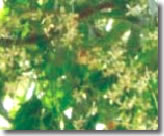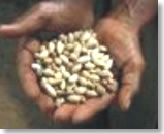
NIMBA/ ARISHTAKA
Botanical Name: Azadirachta indica (MELIACEAE)
English Name: Neem, Margo, Indian Lilia
Hindi Name: Neem (Punjabi: Bakam, Bukhain, Drekh)

Introduction: Its status as national tree justifies the significance of medicinal and commercial value. This is one of the important medicinal plants from ancient times. Rural population use its tender branches as tooth brush even today. Neem leaves are utilized for antiseptic and anti-microbial purpose. Even agricultural usage as pesticide/ insecticide is also in vogue today. Neem is used mainly for the treatment of diabetes and skin diseases. It is also known for its immunomodulatory, anti- stress & antiseptic properties.
Distribution: It is a medium sized tree which is found commonly throughout India.
Chemical Constituents: Bark contains mimbin (0.04%), mimbinin (0.01%), mimbidin (0.04%), mimbosterol (0.03%), essential oil (0.02%), tannin (6.0%) and a bitter principle, margosine ( Bhandari & Mukerji, 1959). Desacetylinimbin isolated from seeds & bark (Narayanan & Iyer, 1967). Quercetin and beta-sitosterol are isolated from leaves (Barak & Chakroborty, 1968).
Parts Used: Root, stem bark, leaves, fruits, seeds & seed-oil.
Properties: Bitter & astringent, cooling effect, anti-mocrobial, antipyretic, anti-pruritic etc.
Indications: Skin diseases, infectious conditions, fevers, worm infestations, itching etc.
Dose: Bark Powder 2-4g, fresh juice 10-20ml, seed oil 5-10 drops.
Therapeutic Uses:
- Allergy: Neem leaves 7 dry amla are powdered and given orally with ghee.
- Spermicidal activity: Seed oil 1- 2 drops applied in vagina before act is spermicidal.
Scientific Studies:
Antidiabetic activity: AE of leaves administered i.v. in dogs significantly decreased the blood sugar levels and prevented adrenaline as well as glucose hyperglycaemia (Murthy et al., 1978). AE of leaf decreased blood sugar in rats (EI – Hawary & Kholief, 1990). In oral GTT, 1 ml leaf decoction, 2.5 ml of seed oil, and 200 mg of nimbidin each significantly delayed peak rise in blood sugar after glucose administration ( Randhawa & Parmar, 1992).
Anti-inflammatory & anti-arthritic activity: Nimbidin ( 40mg/kg b.w.) significantly reduced acute rat paw edema ( Pillai & Shanta Kumari 1981). Bark extract produced significant anti- inflammatory activity (Tidjani et al., 1989; Lorenz, 1976 & Kakai, 1976).
Cardiovascular activity: Leaf extract showed profound hypotensive effect with a minimal negative chronotropic effect and a weak anti- arrhythmic activity in rabbits (Thompson & Anderson, 1978).
Immunostimulant activity: AE of bark showed anti-complement activity, acting both an alternative and classical pathway activation of complement in human serum ( Vander nat et al., 1987). AE of leaf also possessed potent immuno-stimulent activity as evidenced by both humoral and cell mediated responses. It also reserved some stress induced responses in rats ( Sen et al., 1992).
Cultivation Technology: Although the tree can be raised easily in the nursery and transplanted to the field, direct sowings are reported to be more successful for afforestation areas. The seeds are sown in the beds and transplanted during the first rains, when they are 7-10 cm in height and the taproot is 15 cm long.
Harvesting: 5-7 years period is required for the harvesting of bark but leaves may be collected between 2-3 years of period.







